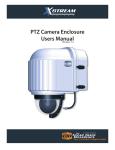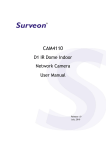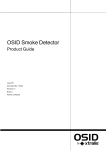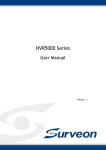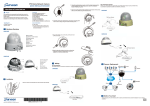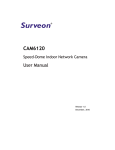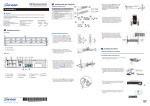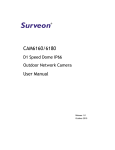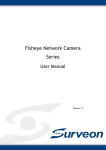Download User Manual
Transcript
CAM42xx Series User Manual Release 1.1 All Rights Reserved © Surveon Technology 2013 Copyright Statement No part of this publication may be reproduced, transmitted, transcribed, stored in a retrieval system, or translated into any language or computer language, in any form or by any means, electronic, mechanical, magnetic, optical, chemical, manual or otherwise, without the prior written consent of Surveon Technology Inc. Disclaimer Surveon Technology makes no representations or warranties with respect to the contents hereof and specifically disclaim any implied warranties of merchantability or fitness for any particular purpose. Furthermore, Surveon Technology reserves the right to revise this publication and to make changes from time to time in the content hereof without obligation to notify any person of such revisions or changes. Product specifications are also subject to change without notice. Trademarks Surveon and Surveon logo are trademarks of Surveon Technology Inc. Other names prefixed with “SMR” and “EMR” are trademarks of Surveon Technology Inc. Microsoft Windows and Windows are registered trademarks of Microsoft Corporation. Linux is a trademark of Linux Torvalds. Solaris and Java are trademarks of Sun Microsystems, Inc. All other names, brands, products or services are trademarks or registered trademarks of their respective owners. 2 Revision History Ver Version Description Date 1.0 Initial release November 2013 1.1 Add new controller icons December 2013 3 Table of Contents Copyright Statement ......................................................................... 2 Revision History ............................................................................... 3 Table of Contents ............................................................................. 4 Safety Precautions ............................................................................ 8 Device Site Recommendations .............................................................. 8 Chapter 1. Product Overview ............................................................... 9 1.1. Network Camera Introduction ..................................................... 9 1.2. Features and Benefits ............................................................. 10 1.3. Technical Specifications .......................................................... 12 Model List for CAM42XX Series ....................................................... 12 Specifications for CAM42XX Series ................................................... 13 Chapter 2. Hardware Overview .......................................................... 17 2.1. Overview ............................................................................. 17 Front View for4221..................................................................... 17 Front View for4211..................................................................... 17 Rear View ............................................................................... 18 Camera Internals (CAM4221) ......................................................... 18 Camera Internals (CAM4211) ......................................................... 19 2.2. Dimensions .......................................................................... 20 CAM4221/4211 .......................................................................... 20 2.3. Functions ............................................................................ 21 2.4. Hardware Installation ............................................................. 22 2.5. Adjustment .......................................................................... 24 2.5.1. 3-axis Gimbal Mechanism: .................................................... 24 2.5.2. Focus Adjuster and Field of View Adjuster (for CAM4221 only): ....... 24 2.6. Wiring ................................................................................ 25 2.7. Reattachment ....................................................................... 27 2.8. Camera Deployment ............................................................... 28 2.9. Before You Start .................................................................... 29 4 Chapter 3. Connecting to the Network Camera ....................................... 30 3.1. Connecting with a Web Browser ................................................ 31 Obtaining IP address through the IP Utility......................................... 31 Connecting to the Network Camera ................................................. 32 Logging into the System ............................................................... 32 Installing ActiveX Components in Internet Explorer .............................. 33 Logging Out of the System ............................................................ 34 Using the Help Interface .............................................................. 34 3.2. Connecting with an RTSP Player ................................................ 35 Chapter 4. Configuration through the Web Interface ................................ 36 4.1. Interface Layout .................................................................... 38 Control Descriptions ................................................................... 39 4.2. Settings............................................................................... 42 General .................................................................................. 42 Basic Settings ...................................................................... 42 User Account ....................................................................... 44 Date & Time ....................................................................... 47 Network ................................................................................. 49 Network Configuration ........................................................... 49 Port Settings ....................................................................... 51 UpnP ................................................................................ 52 Wifi Setting......................................................................... 53 Video & Audio Settings ................................................................ 55 Basic Settings ...................................................................... 55 Image Appearance Settings ...................................................... 56 Video Streams ..................................................................... 60 Audio Settings ..................................................................... 62 PTZ ....................................................................................... 63 Recording................................................................................ 63 Recording Basic Settings ......................................................... 63 Recorded File Management ...................................................... 63 5 Event Notification ...................................................................... 64 Event Server ....................................................................... 64 Motion Detection .................................................................. 66 DI & DO ............................................................................. 68 Event Settings ..................................................................... 70 System ................................................................................... 76 MicroSD Card Management ....................................................... 76 System Status ...................................................................... 76 System Log ......................................................................... 78 Firmware Upgrade ................................................................ 79 Emergency Recovery Procedure ................................................. 79 Resetting to Factory Default Settings .......................................... 80 Export/Import & Reboot ......................................................... 81 Chapter 5. Configuration through the IP Utility ...................................... 82 5.1. Overview ............................................................................. 84 5.2. Installing the IP Utility ............................................................ 84 5.3. IP Utility Basics ..................................................................... 86 Starting the IP Utility .................................................................. 86 IP Utility Main Screen .................................................................. 86 Exiting the IP Utility ................................................................... 87 5.4. Camera Actions ..................................................................... 88 Search.................................................................................... 88 Login ..................................................................................... 89 Properties ............................................................................... 91 Delete from Tool ....................................................................... 93 Select All ................................................................................ 94 Rebooting Camera ..................................................................... 95 Set IP ..................................................................................... 96 Link to Camera Web Interface ....................................................... 98 Link to Camera .................................................................... 98 Link to Camera User Manager ................................................... 99 6 5.5. Camera Group Actions........................................................... 100 Add Group .............................................................................. 100 Delete Group........................................................................... 102 Rename Group ......................................................................... 103 Move to Group ......................................................................... 105 Copy to Group ......................................................................... 107 5.6. Configuration Settings ........................................................... 109 Download Configuration .............................................................. 110 Update Configuration ................................................................. 111 5.7. Firmware Actions ................................................................ 112 Update Firmware ...................................................................... 112 5.8. Focus Tool ......................................................................... 114 7 Safety Precautions Electric Shock Warning This equipment may cause electric shocks if not handled properly. Access to this equipment should only be granted to trained operators and maintenance personnel who have been instructed of, and fully understand the possible hazardous conditions and the consequences of accessing non-field-serviceable units such as the power supplies. The system must be unplugged before moving, or in the even that it becomes damaged. Reliable Grounding Particular attention should be given to prepare reliable grounding for the power supply connection. It is suggested to use a direct connection to the branch circuit. Check for proper grounding before powering on the device. Overloading Protection The device should be installed according to specifications. Provide a suitable power source with electrical overload protection. Do not overload the AC supply branch circuit that provides power to the device. ESD Precautions Please observe all conventional anti-ESD methods while handling the device. The use of a grounded wrist strap and an anti-static work pad are recommended. Avoid dust and debris in your work area. Device Site Recommendations The device should be installed according to specifications. This device should be operated at a site that is: Clean, dry, and free of excessive airborne particles. Well-ventilated and away from heat sources such as direct sunlight and radiators. Clear of vibration or physical shock. Away from strong electromagnetic fields produced by other devices. Available with properly grounded wall outlet for power. In regions where power sources are unstable, apply surge suppression. Available with sufficient space behind the device for cabling. 8 Chapter 1. Product Overview 1.1. Network Camera Introduction CAM42XX series are professional network cameras that use Internet Protocol (IP) to transmit video streams and control signals over networks. Capable of operating over both LANs and WANs, they provide a complete budget-conscious remote surveillance solution that are ultra clear and highly integrated. CAM42XX series combine a user-friendly interface and simplified installation with a powerful feature set to provide users an easy upgrade path to new digital surveillance system in a virtual environment. These highlights make CAM42XX series ideal choices for environments that require remote surveillance or video transmission. 9 1.2. Features and Benefits 42XX series IP camera is a cutting-edge digital video transmission device. It can compress and transmit real-time images of outstanding quality using a reasonable amount of bandwidth through a standard TCP/IP network. The following features make this IP camera an outstanding choice when building an intelligent IP surveillance system: High Video Quality High image quality is essential in security surveillance applications. It is important to be able to clearly capture an incident in progress and identify persons or objects involved. A network camera gives exceptional video quality, even greater than that of traditional analog cameras, which means that more detail or larger areas can be covered. H.264/MPEG-4/MJPEG Compression Motion JPEG, MPEG-4, and H.264 (also known as MPEG-4 Part 10/AVC), each employ different techniques to reduce the amount of data transferred and stored in a network video system. Network cameras that support multiple compression standards are ideal for maximum flexibility and integration possibilities. 10 Dual Streaming Dual-stream design enables simultaneous support of real-time video monitoring, video recording, or mobile viewing applications which require different resolutions, compression formats and frame rates. Tampering Detection This is an intelligent video analytics application available only in selected network cameras in the market. When a camera is manipulated in any way (e.g. accidental redirection, blocking, defocusing, spray-painted, covered or damaged), it can automatically trigger recording and alert notifications. Power-over-Ethernet The built-in Power-over-Ethernet support reduces cabling and installation costs, and enables users to consolidate power facilities for higher reliability. With PoE, a camera can still operate in the event of a power failure if it is connected to a centralized backup power with an Uninterruptible Power Supply. 11 1.3. Technical Specifications Model List for CAM42XX Series CAM42XX Series 12 CAM4221 CAM4211 Megapixel 3-Axis D/N Megapixel 3-Axis D/N IP Fixed Dome IP Fixed Dome Specifications for CAM42XX Series Specifications Description Image Sensor CAM4221 Megapixel 3-Axis D/N Megapixel 3-Axis D/N IP Fixed Dome IP Fixed Dome 1/4" megapixel 1/4" megapixel progressive progressive scan CMOS scan CMOS f2.8-12 mm varifocal lens, Lens f2.8 mm, F1.8 SNR 48dB 48dB WDR Yes Yes Day/Night ICR Yes Yes Yes (10M) N/A 0.01 Lux @ F1.8 (B/W) 0.01 Lux @ F1.4 (B/W) 0.1 Lux @ F1.8 (Color) 0.1 Lux @ F1.4 (Color) Fixed Fixed 1/2 ~ 1/50,000 s 1/2 ~ 1/50,000 s Diagonal: 92°° Diagonal: 87.6°~27.8° Horizontal: 79°° Horizontal: 73°~23.4° Vertical: 49° Vertical: 44.8°~14.8° IR LED General Min Illumination Iris Control Shutter Time Viewing Angle Video CAM4211 Model Name F1.4 Pan 0º ~340º Pan 0º ~340º Camera Angle Adjustment Tilt 20º ~90º Tilt 20º ~90º Rotate ±170º Rotate ±110º Pan/Tilt/Zoom Functionalities N/A N/A H.264/MJPEG H.264/MJPEG Up to 1280 x 800 Up to 1280 x 800 Video Compression Resolution 13 30 fps at WXGA (1280 x 800) 30 fps at HD720 (1280 x Frame Rate 720) 30 fps at D1 (720 x 480) 30 fps at VGA (640 x 480) 30 fps at QVGA (320 x 30 fps at WXGA (1280 x 800) 30 fps at HD720 (1280 x 720) 30 fps at D1 (720 x 480) 30 fps at VGA (640 x 480) 30 fps at QVGA (320 x 240) 240) Video Stream Bit Rate Dual stream at H.264 and Dual stream at H.264 and MJPEG simultaneously MJPEG simultaneously 64K ~ 10Mbps, VBR, CBR, 64K ~ 10Mbps, VBR, CBR, controller frame rate and controller frame rate and quality quality AGC (Auto Gain Control), AWB (Auto White Video Control Balance), AES (Auto Electronic Shutter), image adjustment Motion detection, Intelligent Video tampering detection (blocked, redirected, defocused, or spraypainted) Audio 14 AWB (Auto White Balance), AES (Auto Electronic Shutter), image adjustment Motion detection, tampering detection (blocked, redirected, defocused, or spray-painted) Video Jack N/A N/A Built-in MIC Yes Yes Audio Compression 16KHz, ADPCM/G.711 16KHz, ADPCM/G.711 Audio Input Audio Output I/O and Event Management AGC (Auto Gain Control), Alarm In 3.5mm phone jack (optional) 3.5mm phone jack (optional) 1, terminal block (optional) 3.5mm phone jack (optional) 3.5mm phone jack (optional) 1, terminal block (optional) Alarm Out second post-alarm post-alarm Send snapshot or video Send snapshot or video clip clip by FTP or email, by FTP or email, record to record to NAS, record to NAS, record to local storage, local storage, trigger DO trigger DO IPv4, ARP, TCP, UDP, IPv4, ARP, TCP, UDP, ICMP, ICMP, IGMP, DHCP, NTP, IGMP, DHCP, NTP, DDNS, DDNS, SMTP, FTP, HTTP, SMTP, FTP, HTTP, CIFS, CIFS, PPPoE, UPnP, RTP, PPPoE, UPnP, RTP, RTSP, RTSP, RTCP, 3GPP, ONVIF RTCP, 3GPP, ONVIF 10/100 Base-T / RJ45 10/100 Base-T / RJ45 microSD/SDHC x 1 microSD/SDHC x 1 (Class 4/Class 6 only) (Class 4/Class 6 only) RS-485 N/A N/A USB N/A N/A SDK Surveon SDK 2.0 Surveon SDK 2.0 Microsoft Windows Microsoft Windows XP/Vista/7 XP/Vista/7 Browser Microsoft IE 6.0 or above Microsoft IE 6.0 or above Software Surveon VMS 2.5 Surveon VMS 2.5 Operation: -10°C ~ 50°C Operation: -10°C ~ 50°C (14°F~122°F) (14°F~122°F) 5 to 90% 5 to 90% 12VDC 1.5A;PoE (IEEE 12VDC 1.5A;PoE (IEEE 802.3af) with Class 3 802.3af) with Class 3 Max. 7W Max. 5W ø110mm x 100mm (H) ø110mm x 100mm (H) Supported Protocols Ethernet Local Storage OS Viewing System Temperature Humidity General 1, terminal block (optional) 5 second pre-alarm, 5 second Event Action System (optional) 5 second pre-alarm, 5 Video Buffer Network 1, terminal block Power Power Consumption Dimension 15 Weight Certification 16 Net: 345g Net: 345g Gross: 585g Gross: 585g Safety: LVD Safety: LVD EMC: FCC, CE EMC: FCC, CE Chapter 2. Hardware Overview 2.1. Overview Front View for4221 Front View for4211 17 Rear View Camera Internals (CAM4221) 18 Camera Internals (CAM4211) 19 2.2. Dimensions CAM4221/4211 Unit: mm (Ø ) 20 2.3. Functions For models with I/O cables supplied: 1. Audio In/Out Audio In/Out are both for 3.5mm jacks. Audio In provides for an external mono microphone. Audio Out can be connected to a public address system or an active speaker with a built-in amplifier. A pair of headphones can also be attached. 2. I/O Terminal Connector This connector contains DO, DI, 12V and GND. 3. Power Connector The power connector is provided for solutions without PoE. 21 2.4. Hardware Installation CAM4221 CAM4211 1. Open and take out the dome cover from the base.Loosen the lock ring to adjust the desired angle of the camera. 2. Use the dome base to mark the desired camera position and make 3 holes for the anchors and then put the anchors into the holes. Use the screws to fix the camera unit on the surface of a ceiling or a wall. Dome Base The screw holes are slightly bigger than the screws for easy adjustments. 22 CAM4221 CAM4211 NOTE: Cables can go through either the base or side cable entry. When choosing the base, remember to drill a hole for the cable entry. 23 2.5. Adjustment 2.5.1. 3-axis Gimbal Mechanism: The cameras can be panned, tilted, and rotated to its required position. 2.5.2. Focus Adjuster and Field of View Adjuster (for CAM4221 only): 24 2.6. Wiring 2.6.1. Connecting the LAN cable via a PoE switch: Once it’s connected and electrified, follow the instructions from 2.5. Adjustment to have the desired viewing angle and have the camera finetuned. 2.6.2. Connecting the I/O cables: Once it’s connected and electrified, follow the instructions from 2.5. Adjustment to have the desired viewing angle and have the camera finetuned. 25 Use the cable tie supplied to fasten the I/O cables onto the camera unit otherwise it may be come off or dragged out. Cut the redundant cable tie off. Note: Before using the cable tie to fasten the I/O cables, be sure to make camera adjustments first. Otherwise the cable tie may stand in the way for any adjustment. 26 2.7. Reattachment Once the wiring and the camera adjustments are done, the dome cover should be reattached back. Put the dome cover back by pointing the notches on the camera unit and the dome cover together and then turning the dome cover anti-clockwise. The dome cover is fastened when you hear a click sound. Note: When choosing the side cable entry, make sure the knock-out is removed before putting the dome cover back. 27 2.8. Camera Deployment 28 2.9. Before You Start Please prepare a PC with Windows (XP or above) and web browsers installed. 29 Chapter 3. Connecting to the Network Camera This section demonstrates how to connect to the network camera through two methods: Web Browser – A simple web-based interface. Internet Explorer is the recommended web browser for use with network cameras, and our examples will be from this browser. Usage on other browsers will be similar. RTSP Player – These include common streaming media players, such as RealPlayer or Quicktime Player. These players can provide live view of the camera using the Real-Time Streaming Protocol (RTSP). 30 3.1. Connecting with a Web Browser Obtaining IP address through the IP Utility The IP address can be obtained using the IP Utility in your product CD: 1. Double click Start SearchToolInstall.exe to begin the utility installation. 2. After the installation is complete, click the Auto Search button or click Camera > Search in the menus. The camera search will begin, and a status bar will display the search progress. 3. The details of the camera will display after the search is finished. Note: (1) The search may take up to 2 minutes, depending on your network configuration. (2) If your network does not have DHCP service, the default IP address is 192.168.88.10. 31 Connecting to the Network Camera Launch the web browser (Microsoft ® Internet Explorer 6.0 or higher is recommended). Enter the IP address of the network camera in the address bar of your browser and press enter. You can also Click the Link to Camera button or click to Camera> Link to Camera in the IP Utility menu bar. The camera’s live view webpage will open in a browser window. Logging into the System The following information will prompt for logging in: Username – The username for the domain. Default is always admin. Password – The password for the domain. Default is always admin. Click OK. 32 Installing ActiveX Components in Internet Explorer You may be prompted to install ActiveX® components when accessing the network camera’s Live View page; click Yes when prompted. You will be able to access the camera after installation is completed. Under Windows, this action may require administrator privileges. If the dialog box suggests that you are not allowed to install ActiveX components, try resolving the problem using the following steps: 1. In Internet Explorer, open Tools> Internet Options> Security. Click the Custom level button. 2. Search for Download signed ActiveX controls. Under this heading select Prompt and then click OK. 3. Continue installing the Active X components. 4. After installing ActiveX, go to Tools> Internet Options> Trusted Websites> Sites and add the IP Address of the camera. 33 Logging Out of the System Logging off of the camera can be performed by closing the browser window. Users can also choose to click the Logout link located at the top of the screen. Using the Help Interface While using the web interface, you may click on the Help link located under the title bar. This will bring up a pop-up containing the IP Camera Help manual. This provides simple explanation of the camera settings, and will automatically open to the page relevant to your current screen. The help manual is organized so that it matches the system menus, with sections corresponding to each settings menu and the Live-view window. 34 3.2. Connecting with an RTSP Player Connections through RTSP Media Players such as Real Player and QuickTime Player are supported. We will use Real Player as an example in this section. 1. Launch Real Player. 2. Select File > Open URL, to open a URL dialog box. 3. Enter the camera URL in the address bar. Note: The format for RTSP is: rtsp://<IP Address>/<Access>, where <Access> can be found at Settings> Network> Port Settings> RTSP Setting. By default the <Access> value should be stream1 and stream2. 4. Click OK, the stream should begin playing. 35 Chapter 4. Configuration through the Web Interface Camera configurations can be done through web interface and IP Utility. **For web interface, please look into this chapter; for IP Utility, please refer to Chapter 5. Web Interface IP Utility Basic Settings V X User Account V X Date & Time V X Network Configuration V Set IP Only Port Settings V X V X Wifi Setting V X Basic Settings V X Image Appearance Settings V X Video Streams V X Audio Settings V X PTZ RS-485 Settings/PTZ Settings V X Recording Recording Basic Settings V X Recorded File Management V X Event Server V X Motion Detection V X Tampering Detection V X DI & DO V X Event Settings V X MicroSD Card Management V X System Status V V System Log V X Firmware Upgrade V V Resetting to Factory Default Settings V X General Network UpnP Video & Audio Settings Event Notification System 36 Export/Import V X Reboot V V Camera Search X V Login V V Properties X V Delete from Tool X V Clearing and Setting Status X V Camera Group Actions X V Configuration Settings X V Focus Tool X V 37 4.1. Interface Layout This section demonstrates the layout of the network camera’s main interface. The 4 main areas on the interface are: 1. Menu Bar - The links on this bar allow users to toggle between liveview and settings screens, as well as logout and pull up the help menu. 2. Live View Controls - These controls allow users to configure the live view streams and camera live view functionality. 3. Button Bar - These controls allow the user to quickly access common features such as live view window resizing, video and still frame capture, interface language, and audio controls. 4. Live View Window - This portion of the screen displays the stream selected in the Live View Control section of the web interface. 38 Control Descriptions Control Description Adjust Window Size: When clicked, the display window size can be adjusted manually to fit the screen. The screen size changes back to the actual image size (resolution). Full-Screen: Goes to full-screen when clicked; press “ESC” to return to windowed view. Image Capture: When clicked, captures the current screen as an image in a new pop-up window. The location for saving the image can be changed under Settings > Recording> Recording Basic Settings. The file name is set to “Camera Name”+yyyymmdd_hhmmss (the Camera Name can be changed under Settings > General> Basic Settings). Manual Record: When clicked, records the current live video. Stops recording when clicked again. The location for storing the video can be changed under Settings > Recording > Recording Basic Settings. Audio-In: Turned off by default; clicking once allows audio to be transmitted from a local microphone to the camera. Clicking again stops audio transmission. Multiple users may access the live view page and receive audio from the camera, but only one user at once is allowed to send audio to the camera. Mute: Mutes the audio captured by the camera when clicked, un-mutes the audio when clicked again. Volume: Sets to the current computer volume; Dragging the slider adjusts the volume. 39 Control Description Language: Sets the UI language. Available languages include English, Simplified Chinese, and Traditional Chinese. Streams: Allows users to choose which camera stream to view. The indicator above the stream will turn light green when the stream is selected. Video Format: Sets the compression format for the current stream. Available formats are H.264, MPEG4, and MJPEG. Image size (resolution): Sets the resolution of the stream currently selected. Options are available for each stream: 1080P (1920 x 1080), SXGA (1280 x 1024), 720P (1280 x 720), D1 (720x480), VGA (640x480) and QVGA (320x240) for steam1; 640x360, 320x 180 and 192x108 for stream2. Digital Zoom: When clicked, activates digital zoom in the current live-view stream. 2 options are available when clicked: Zoom In Zoom Out To set the digital output as high voltage or ground or off can be done here. To magnify the image, change its focal length to vary its view from 0 to 16. Change the depth of field by adjusting the Near and Far steps. 40 Control Description AutoFocus can be achieved by pressing this button. P-IRIS level can be adjusted Manually or Automatically. 41 4.2. Settings Camera settings may be changed by clicking on the Settings link located in the title bar. This will bring up a menu list of configuration menus for all major camera settings. General General setting menus are found under Settings > General. Basic Settings Basic settings may be accessed under General> Basic Settings. The following settings can be made: Host Name: by default set to "model name + MAC address"; displays on the center of the main page. Users may replace the default name with a new name consisting of alphanumeric characters, spaces and the ":" character. Camera Name: by default set to "model name"; after selecting Camera Name” from Settings> Video & Audio> Basic Settings, the Camera Name will show on the display. Users may replace the default name with a new name consisting of alphanumeric characters, spaces and the ":" character. System Status LED: changes the behavior of the status LED on the front of the camera. There are four possible behaviors: 42 o LED on when camera is on - LED default on, flashing during camera access. o LED on during camera access - LED default off, flashing during camera access o LED off during camera access - LED default on, off during camera access o LED always off - LED always off Click OK to save or Cancel to abort the changes before you leave the page. 43 User Account The User Account section, found under General> User Account, controls the user account information and privileges. There are two pre-configured accounts: admin - This is the default administration account, and cannot be deleted. guest - This is an account with only live view capability. There are also two basic settings under user account settings: Enable access without login - Checking the checkbox will allow users to view the camera stream without having to login. Maximum number of simultaneous viewers limited to - Enter a number from 1 to 10 in this field to limit the number of users that can view the live view stream for this camera. This option will only be displayed once you add an account. Click OK to save or Cancel to abort the changes before you leave the page. 44 Adding Accounts In General > User Account under the User Account heading, click on “Add”. Up to 10 accounts can be added to the system. All User Names and Passwords must be combinations of alphanumeric characters, “:”, “-“, “_” between 4 and 20 characters in length, and must begin with an alphabet letter. Fill out the following fields: User Name - The identifier name used to login to the system. User Group - The system allows for 2 types of users. o Administrator - Administrators have full access privileges. o Operator - Operators can only access the live view page. Password - A passkey used to control user access. The password must be a combination of alphanumeric characters, “:”, “-“, “_” between 4 and 20 characters in length, and must begin with an alphabet letter. This password should be retyped in the Confirm password field, to ensure that the correct key is saved. Click OK when finished to add the user to the system. 45 Editing Accounts In General> User Account under the User Account heading, select an existing account by clicking on the account entry. The entry will be highlighted in yellow. Clicking Edit will allow you to change the following fields: User Group - The system allows for 2 types of users. o Administrator - Administrators have full access privileges. o Operator - Operators can only access the live view page. Password - A passkey used to control user access. The password must be a combination of alphanumeric characters, “:”, “-“, “_” between 4 and 20 characters in length, and must begin with an alphabet letter. This password should be retyped in the Confirm password field, to ensure that the correct key is saved. Click OK when finished to save any changes. Note: Only accounts that are not currently logged-in can be edited. Deleting Accounts In General > User Account under the User Account heading, select an existing account by clicking on the account entry. The entry will be highlighted in yellow. Click Remove and, when prompted to confirm deletion, click OK to remove the account. 46 Date & Time Date and time settings can be accessed at General> Date & Time. Current Date & Time displays the current system date and time. Time Zone Settings The time zone can be set using the dropdown menu. This menu is only applicable when selectable when Synchronize with NTP Server is chosen under Time Settings. Time Settings There are 3 ways to set the system time: Synchronize with NTP server - NTP is a protocol for synchronizing the system clock to an external server. If this option is chosen, enter the IP address of a known NTP server in the NTP Server field. You must also choose the appropriate time zone under Time Zone Settings. Manual update - Updates the time manually. Choose the appropriate date and enter a time for the system. 47 Synchronize with computer time - Synchronizes the time with the computer’s internal clock. Day Light Saving Users can set the Day Light Saving Time by ticking on Enable Day Light Saving. Click OK to save or Cancel to abort the changes before you leave the page. 48 Network The network settings, including network configuration, port configuration, and universal plug and play (UPnP) settings are used to configure camera connectivity. These settings are found under the Settings > Network context. Network Configuration These settings are used to configure basic network access for the camera. They are found under Network> Network Configuration. Most of these settings vary with your specific hardware setup; therefore the defaults are set for common SOHO level usage. If you are using the camera in an enterprise environment, please check with your IT department to determine the correct settings for this section. IP & DNS Settings These settings are used determine the IP address of the network camera. Get IP address automatically - Automatically acquires IP address from a DHCP service. This is the default setting. 49 Use fixed IP address - Sets a fixed IP address. You must also manually fill in IP address, Subnet mask, Default gateway, Primary DNS, and Secondary DNS fields. The network camera can be connected to the network upon completion. PPPoE Settings This feature is disabled by default. Connecting to the network using PPPoE (Point-to-Point Protocol over Ethernet) requires a user name and password from your ISP (Internet Service Provider). Select Enable PPPoE and fill in valid user name and password to connect the camera to the Internet. DDNS Settings DDNS (Dynamic Domain Name Server) is a protocol that enables the camera to maintain a static connection address, even when its IP changes. Access using this feature is disabled by default. Connecting using DDNS requires registration on third-party websites for DDNS services. Select desired DDNS service website, check the Enable DDNS option, and fill in valid user name and password. You can then access the camera through the registered domain name. Click OK to save or Cancel to abort the changes before you leave the page. 50 Port Settings Ports are a software construct used to multiplex the transmission information to and from the camera. They act as separate endpoints within an IP address where software "listens" for incoming information. This section, which can be accessed under Network > Port Settings, includes HTTP Port Settings, RTSP Settings and RTP Multicast Settings. Note: The default port numbers in this section are, for the most part, wellknown or commonly known values. We recommend that they not be changed unless there is a specific reason to do so. HTTP Port Settings The HTTP port number is used access the camera via the HTTP protocol. The LiveView Port number is used to transmit live-view information. RTSP Settings Real-Time Streaming Protocol (RTSP) is a protocol used to establish and control media sessions between end points. 51 You may change the access name for stream 1, stream 2, the RTSP port number, the RTP port for video, the RTCP port for video, RTP port for audio, and RTCP port for audio. Note: The RTP port number must be an even number. After entering the RTP port number, the RTCP port number will automatically be set to the RTP port number + 1. RTP Multicast Settings Tick Enable RTP Multicast to set up multicast via the RTP protocol. The RTP Multicast video/audio port and group address can also be set. Click OK to save or Cancel to abort the changes before you leave the page. UpnP Universal plug and play (UPnP) is a protocol that simplifies the implementation of networks by allowing new hardware to connect seamlessly to a network. The settings for this feature can be found under Network> UPnP. To enable UPnP, first check the Enable UPnP box. If you wish to change the default values, there are two fields that can be edited. 52 Friendly Name - An identifier for the camera on the network. Interval - The time between camera-sent UPnP updates. Click OK to activate UPnP or Cancel to abort the changes before you leave the page. Once activated, the camera will be visible to other devices on the network. Note: If the computer does not have UPnP installed, you can add it by going to Start> Control Panel> Add or Remove Programs. In the Add or Remove Programs page, select Add/Remove Windows Components>Networking Services and click Details. Select UPnP from the popup window, and OK out to install UPnP services. Wifi Setting Users can use a USB dongle to access Wifi: 1. Insert a wireless USB adapter into the USB connector. 2. Tick Enable Wifi and click Search. 3. Select a SSID (Service Set Identifier) and Click Connect. 4. The following window will pop out. 53 Enter the Password in Password and Confirm Password. Click OK to save or Cancel to abort the changes before you leave the page. Note: Only WEP (Wireless Encryption Protocol) is supported; WAP (Wireless Application Protocol)/WAP2 are not supported. 54 Video & Audio Settings Video and audio are the heat of a network camera's functionality. The settings for video and audio can be found under Settings> Video & Audio. Under this section, you can access basic video and audio settings, video appearance parameters, video stream settings, as well as audio parameters. Basic Settings Basic settings pertain to simple live-view tweaks. These parameters can be found under Video & Audio> Basic Settings. Video Orientation In certain mounting situations, the default video output may not be oriented correctly. This setting allows you to change the orientation of the output video. Flip - flips the image vertically. Mirror - flips the image horizontally. Text Overlay Setting The text overlay involves is the text displayed in the black bar at the top of the output screen. You can display multiple text messages at the same time. (Only the camera name will display if the resolution is 160 x 120). Include Date - Displays the current date. Include Time - Displays the current time. Camera Name - Displays the name of the camera. 55 Image Appearance Settings These settings, found under Video & Audio > Image Appearance, deal with the video output of the camera. There are two tabs, Image Attributes and Sensor Configuration, as well as Advanced Settings. The details for each model are listed below. Image Appearance Image Attributes These parameters deal with the image lighting and color. All parameters are values ranging from (0) to (100). Dragging the slider to the right increases the value, while dragging to the left lowers the value. The adjustments will be displayed in real-time in the window to the left of the sliders. Brightness - Adjusts the brightness of the image. Note: In certain situations, the sensor may experience banding issues. In these cases, please turn raise the brightness. 56 Saturation - Adjusts the saturation of the image. Contrast - Adjusts the contrast of the image. Sharpness - Adjusts the sharpness of the image. Sensor Configuration The Sensor Configuration can be accessed by clicking on the tab to the right of the Image Attributes tab. The following parameters can be changed: D-WDR - Specifies if the wide dynamic range (WDR) function is activated. If activated, the WDR function will attempt to preserve detail at contrast extremes. o D-WDR Level- Specifies the WDR correction level ranging from 1 (least) to 10 (most). Advanced Settings The Advanced Settings allow you to make changes to the following parameters: 57 Frequency - The user can choose to compensate for 50Hz or 60Hz lighting. Denoise – Removes video noises. Max Shutter Speed - Longer shutter times allow more light into the sensor, resulting in a cleaner picture, however longer shutter times can result in motion blur. The user may choose the following shutter speeds: 1/2s, 1/5s, 1/7.5, 1/15s, 1/30s, 1/60s, 1/120s, 1/250s, 1/500s, 1/1000s and 1/10000s. AGC Gain - Automatic gain control (AGC) adjusts the video gain level to a variety of inputs. This setting provides a baseline value for the AGC. Values higher than this will be darkened, and values that are lower will be brightened. AGC should be adjusted so that the area of interest is best lit. White Balance - This setting allows users to choose the color balancing method used. o AWB - Automatically chooses white level. o MWB - The user must specify the red and blue gain levels to achieve the correct white level. R Gain - The gain applied to the red video channel. B Gain - The gain applied to the blue video channel. Day/Night Mode - Sets the day (color) and night (black and white, IR cut filter off where applicable.) Night mode sacrifices color information to produce a clear picture with less light. o Auto – The camera will automatically choose between day/night mode. Night Threshold – Once selected, the camera will switch to night mode. Set the value in 0~255. Day Threshold - Once selected, the camera will switch to day mode. Set the value in 0~255. o Day mode - Forces day mode. o Night mode - Forces night mode. o Schedule for day mode - Allows the user to set a time for day/night transitions. 58 From: - The time, in hours and minutes, when the camera will be in day mode. To: - The time, in hours and minutes, when the camera will switch to night mode. Chroma Suppress - Reduces the false color phenomena. Click OK to save or Cancel to abort the changes before you leave the page. 59 Video Streams The configuration for video streams, including resolution, frame rate and image quality parameters can be found under Video & Audio> Video Streams. The page is split into settings for 2 streams. Common settings are: Video format - The compression format for the video stream. o H.264 - Provides the best compression, and clear picture, but is processor intensive. o MJPEG - Provides minimal compression, with the best picture quality. Each frame is stored as a discrete JPEG. This option is only available in Stream 1. Video Resolution - Sets the resolution of the video output. The following options are available: 1080P (1920 x 1080), SXGA (1280 x 1024), 720P (1280 x 720), D1 (720x480), VGA (640x480) and QVGA (320x240) for steam1; 640x360, 320x 180 and 192x108 for stream2. 60 Video Frames per Second - Sets the number of frames per second. 1, 2, 3, 5, 10, 15, 20, 25, 30 FPS are possible values. You can also choose to type in the values you want (the range is from 1~30). Key Frame Interval - Sets the period between minimally compressed recovery frames that don't require other video frames to decode. 1s, 2s, 3s, and 4s are possible values. Video Quality Settings - Sets the quality of the video image. Constant Bit Rate - In this mode, the camera will maintain a constant bit rate output, regardless of video quality. Bit rates available are dependent on the video resolution chosen, and range from 128 kbps to 10 Mbps. You can also choose to type in the values you want (the range is from 32~10240). o Fixed quality - In this mode, the camera will attempt to maintain a constant quality output, up to a maximum bandwidth of 10 Mbps. Click OK to save or Cancel to abort the changes before you leave the page. 61 Audio Settings The audio settings, under Video & Audio> Audio Settings, contain parameters dealing with audio coming from the cameras built in mic, or an external microphone. Mute - Selects whether or not to mute the incoming audio from the camera. Audio In - Selects the source for the camera audio feed. Line In, an external source connected to the camera's line-in port, is the only option. ADPCM Bit Rate - Adaptive differential pulse-code modulation (ADPCM) is a method for digitally encoding audio signals. Only one bit rate, 32 Kbps, is currently supported. Audio will be encoded at this bit rate. Click OK to save or Cancel to abort the changes before you leave the page. Note: Only Stream 1 supports audio. 62 PTZ Note: CAM 42XX series do not support PTZ functionalities. Recording The Recording menu, Settings> Recording, deals with recording settings and managing recorded video files. Recording Basic Settings Recording basic settings, Recording > Recording Basic Settings are parameters which deal with the recording location and scheduling. The following parameters can be configured within this menu: Manual Record To - Defines the path for manual recording. Screenshots and user recordings will be saved in this location. Event/Schedule Record To - Allows the user to set the destination for event or scheduled recording. Event and scheduled recording settings are found under Settings> Event Notification. Click OK to save or Cancel to abort the changes before you leave the page. Recorded File Management Note: CAM 42XX series do not support Recorded File Management. 63 Event Notification Event Notification settings, found under Settings> Event Notification, deal with the event detection, scheduled recording, and notification abilities of the camera. Event Server The event server, which can be configured under Event Notification> Event Server, is the communications center of the camera. This section deals with the configuration of E-mail and FTP notifications, as well as remote recording. Email Settings Email settings are used to configure e-mail notifications. Sender Email Address – The return e-mail address for notifications. This should be your notification address. Recipient email address – The e-mail address notification emails will be sent to. Only one email address can be entered. 64 Server address - The IP or address of the e-mail server. User Name - The user name of the notifications e-mail account. Password - The password of the e-mail account. SMTP Server Port - the SMTP port of the email server; Default 25. Test - Click this button to send a test email. E-mails will only be sent if all parameters are entered correctly. FTP Settings FTP settings are used to configure recording to a remote location via the file transfer protocol. Server Address - The address of the FTP server. FTP Server Port - The port number of the FTP server; Default 21. User Name - The user name of the FTP account. Password - The password of the FTP account. FTP Folder Name - The name of the folder on the FTP site which video files will be stored in. NAS Settings NAS settings are used to configure recording to network attached storage. Server Address - The address of the NAS server. User Name - The user name of the NAS account. Password - The password of the NAS account. Folder Name - The name of the CIFS account folder on the server. Click OK to save or Cancel to abort the changes before you leave the page. 65 Motion Detection The motion detection functionality of the camera can be found under Event Notification> Motion Detection. Motion Detection Window Management To detect motion, first a detection window must be created. First click the Window Settings tab to enter the window configuration, and click New to add a new detection window. A maximum of 3 motion detection windows can be added. Each new window will be created with a default name Window N, where N is the number of the window. After creating the window, clicking it will select the window. You can drag and resize the window using your mouse. You can also change the following parameters: Window Name - Tthe name of the motion detection window. Trigger Interval - The time interval between motion triggers. Options available are: 200 ms , 400 ms, 800 ms, and 1000 ms. Trigger Threshold - The percentage change in the window before a motion alarm is triggered. Sensitivity - The sensitivity of the motion box. Click Save to save all settings. Settings of existing windows can also be changed by selecting the window and changing the settings. To delete a window, select a window in and click Remove. 66 After windows are set, you can activate motion detection by checking the Enable Motion Detection box. Activating and Scheduling Motion Detection Motion detection is activated by checking the Enable Motion Detection box. Activate Motion Detection By: denotes when motion detection will be triggered as an event. Auto – As long as Enable Motion Detection is checked, an event is triggered. Schedule – Selecting this option allows to manually schedule the times motion detection will be active. Select the days of the week that Motion Detection is active by checking the corresponding boxes, and fill in a start time and end time for motion detection in the From: and To: boxes. Click OK to save or Cancel to abort the changes before you leave the page. Triggering a Motion Event The video displaying on the window is the live streaming video. The Activity Status Display tab displays the amount of motion detected in a selected window. By raising the Sensitivity of the window the motion values for a given motion, which are in shown in yellow, will be higher. When the motion value reaches or crosses the Trigger Threshold, denoted by the red line, a motion event will be triggered. Motion alarm handling and notifications can be configured under Event Settings. 67 DI & DO Digital Input (DI) and Digital Output (DO) stand are used for event triggering. The camera has 1 DO and 2 DI ports. Settings for these ports can be found under Event Notification > DI & DO. Conditions for DI and DO triggering, as well as notifications for can be set under Event Settings. Digital Input The two inputs are listed as Input1 and Input2 and connect to external circuits such as window break detectors. These inputs can be tested by clicking the Test button in the input entry. Each input has a Normal Status: Normal Open – the DI requires a low voltage input, with the following configuration. DI GND It is triggered when it does not receive this input. Normal Close – the DI requires a high voltage input (+12V), with the following configuration. +12V DI It is triggered when it does not receive this input. 68 Off - DI inputs are closed at all times. The camera will not respond to any signals on this DI. Digital Output The camera can also be configured to send signals through the digital output. Each output has a Normal Status: High – DO outputs a high voltage when triggered, and is connected to the output circuit in the following manner: Low - DO acts as a ground when triggered, and is connected to the output circuit in the following manner: Off - Closes DO output; no signals will be sent. Click OK to save or Cancel to abort the changes before you leave the page. 69 Event Settings Event settings deal with alarm handling and notification, as well as feature scheduling. These settings can be found under the Event Notification> Event Settings menu. The event handler is rule based. There are lists for both two types of rules: Event List – Contains rules based on triggered events such as motion detection or DI triggers. Schedule List – Contains time-based rules. Each rule has an action list. When the conditions for rule are met, the actions specified by the rule are carried out. Users may perform the following actions in both Event and Schedule lists: Add – Clicking on the Add button adds a new rule to a list. Select – Clicking on an existing rule selects the rule, highlighting it in yellow. o Edit – A selected rule may be edited by clicking on the Edit button. o Delete – A selected rule may be deleted by clicking on the Delete button. 70 Adding/Editing an Event Rule The Add and Edit screens contain the following triggering actions: Note: If editing a rule that has not been triggered, the rule will not be triggered after until after editing is complete. If the rule is triggered, any changes will not be applied until the current trigger is resolved. General The following general fields should be filled in: Name - Specifies the name of the Event. Minimum time interval between triggers - The time frame in which a subsequent trigger of the same event will be ignored (maximum 23:59:59). Enable Triggering By The next step is to specify the frequency of trigger response. 3 options are available: Always - The default setting; Triggers event when conditions are met. Recurrence Pattern - Enables triggering only if conditions are met during a specified time period. To specify the period, select the days 71 of the week that the trigger is active by checking the corresponding boxes, and fill in a start time and end time for motion detection in the From: and To: boxes. Never – The event is never triggered. Enable Triggering By After the frequency is selected, triggering conditions can be set. Multiple conditions can be set at once. Available options include: Motion Detection - Trigger when motion is detected. o In Window – Specifies the detection window that will trigger the event. Please refer to the section on Motion Detection for details. On Boot - Trigger when camera reboots. Video Loss & Tampering Detection - Trigger when video signal is lost or tampering is detected. Please refer to the section on Tampering Detection for more detail. Disk Full - Trigger when the SD disk installed in the camera is full. DI - Trigger when a DI trigger occurs. For more information please refer to the section on DI & DO. When Triggered The actions to take when trigger conditions are met are configured here. 72 The following options are available: Streams – Selects the stream from which the snapshot or recording will be obtained. Email – E-mails notifications to the email address specified in the Event Server settings. If this option is chosen, fill in the following: o Subject - The subject line of the notification e-mail. o Additional Information - Contents of the notification e-mail. o Snapshot/Video Clip - Choose to send a snapshot or video attachment from 5s before to 30s after the trigger. FTP - uploads a snapshot or video clip to a FTP location specified in the Event Server settings. o Snapshot/Video Clip - Choose to upload a snapshot or video file from 5 seconds before to 30 seconds after the trigger. Files are sent as attachments. Record - Records video to the server specified in the Event Server settings when triggered. The video clip stored on both remote storage server and local storage is a video file 35 seconds in length (5 seconds before and 30 seconds after the trigger) Trigger DO –A Digital output signal is sent when triggered. o Trigger Duration - The length of time that the DO signal is sent. Options are 1, 2, 5, 10, 20 or 30 seconds. For more information please refer to the section on DI & DO. Click OK to save or Cancel to abort the changes before you leave the page. Adding/Editing a Scheduled Rule The Add and Edit screens contain the following actions: 73 Note: If editing a rule that has not been triggered, the rule will not be triggered after until after editing is complete. If the rule is triggered, any changes will not be applied until the current trigger is resolved. General The following general fields should be filled in: Name - Specifies the name of the Event. Set Time Interval (When Activated) - The trigger time of the event (00:00 to 23:59). Enable Triggering By The next step is to specify the frequency of trigger response. 3 options are available: Always - The default setting; Triggers event when conditions are met. Recurrence Pattern - Enables triggering only if conditions are met during a specified time period. To specify the period, select the days of the week that the trigger is active by checking the corresponding boxes, and fill in a start time and end time for motion detection in the From: and To: boxes. 74 Never – The event is never triggered. When Triggered The actions to take when trigger conditions are met are configured here. The following options are available: Streams – Selects the stream from which the snapshot or recording will be obtained. Email – E-mails notifications to the email address specified in the Event Server settings. If this option is chosen, fill in the following: o Subject - The subject line of the notification e-mail. o Additional Information - Contents of the notification e-mail. o Snapshot/Video Clip - Choose to send a snapshot or video attachment from 5s before to 30s after the trigger. FTP - uploads a snapshot or video clip to a FTP location specified in the Event Server settings. o Snapshot/Video Clip - Choose to upload a snapshot or video file from 5 seconds before to 30 seconds after the trigger. Files are sent as attachments. Record - Records video to the server specified in the Event Server settings and the microSD card when triggered. The video clip stored on both remote storage server and local storage is a video file 35 seconds in length (5 seconds before and 30 seconds after the trigger) Trigger DO –A Digital output signal is sent when triggered. o Trigger Duration - The length of time that the DO signal is sent. Options are 1, 2, 5, 10, 20 or 30 seconds. For more information please refer to the section on DI & DO. Click OK to save or Cancel to abort the changes before you leave the page. 75 System The system settings, which deal with hardware and firmware parameters, logs, and configuration lists, can be found under Settings> System. MicroSD Card Management MicroSD class 2/4/6 cards can be accessed for offline video storage and upgrade purposes. MicroSD installed in the camera can be managed under System > MicroSD Card Management. System Status The camera status can be found under System> System Status. This section displays useful system information including: 76 Network Configuration defined manually or obtained from DHCP o IP Address o MAC Address o Subnet Mask o Default Router address Camera System Information o Boot Loader Version o Firmware Version Clicking on the Email button will send the system status information out to the notification e-mail address specified in Event Server for troubleshooting or reference purposes. 77 System Log The system log, System > System Log, provides a log for system messages and events. The log lists important information such as login information, changes to camera settings (both successful and unsuccessful), triggered events, and error messages. This information can be very useful in the event of a camera failure or unauthorized entry. Clicking Email will send the log out as an email the notification e-mail address specified in Event Server; Clicking Download will begin the browser download process to download the log to the local PC. 78 Firmware Upgrade Upgrading with a firmware file on a PC: 1. Power ON the device. 2. Connect to the camera through a web browser and go to System > Firmware Upgrade. 3. Choose “Specify the firmware to upgrade”. Click Browse…and locate the file [cam number]fw. 4. Select Keep customized configuration to keep current configuration settings, or Upgrade all configurations to clear all settings back to factory defaults. 5. Click Upgrade to start the upgrade. Upon completion of firmware upgrade, the camera will reboot (you will be logged off). 6. The LED will flash amber during the firmware upgrading. The camera will start reboot after firmware upgrade completed. 7. When the LED indicator turns green, the firmware is upgraded successfully. Emergency Recovery Procedure If the status LED shows steady amber for over 1 minute, the camera will become unresponsive and the upgrade process may have failed. Please contact with your dealer for technical support. 79 Resetting to Factory Default Settings To reset the device to the factory default settings: 1. Make sure the device is in operation mode. 2. Using a needle or similar object to press and hold the Reset button until the camera restarts (about 2 seconds). The status LED will change to amber during startup. 3. When the Status Indicator changes to back to Green (which may take up to 1 minute), the process is complete. The default IP address is 192.168.88.10 if not assigned by a DHCP server. Note: Resetting to the factory default settings using the Reset button will cause all parameters (including the IP address) to be reset. To reset the unit without changing parameters, disconnect and reconnect the power connector. Camera resets can also be performed under System> Reset To Factory Default. There are 2 types of reset. You can either reset all settings and configurations, or you can choose to keep the Network configuration, and reset all other settings and configurations. Click OK after choosing a reset option to perform a reset. Alternately, you may press the “Reset” button on the bottom of the camera to perform a complete reset of the camera (no configurations retained). To reset the camera by pressing the “Reset” button on the bottom of the camera, press and hold the “Reset” button for 3 seconds. During this time, the LED indicator in front of the camera will blink in red. 80 Export/Import & Reboot In certain situations it may be necessary to restart your network camera (network settings changed, DHCP added, etc). The settings under System> Export/Import & Reboot allow you to restart the camera. This menu also contains options to export configuration details (for backup or replication purposes), as well as import configuration details. The following options are available: Restart Camera - Resets the camera when Apply is clicked. Export Configuration - Export the camera’s settings and configurations by clicking Export, this will start a browser dialogue to download the configuration. Export Log Import Configuration - Imports previously exported camera settings. The field should contain the path for the camera configuration file. Click Browse: to browse your PC for the configuration file. Click Apply to import the settings. 81 Chapter 5. Configuration through the IP Utility Camera configurations can be done through web interface and IP Utility. **For IP Utility, please look into this chapter; for web interface, please refer to Chapter 4. Web Interface IP Utility Basic Settings V X User Account V X Date & Time V X Network Configuration V Set IP Only Port Settings V X V X Wifi Setting V X Basic Settings V X Image Appearance Settings V X Video Streams V X Audio Settings V X PTZ RS-485 Settings/PTZ Settings V X Recording Recording Basic Settings V X Recorded File Management V X Event Server V X Motion Detection V X Tampering Detection V X DI & DO V X Event Settings V X MicroSD Card Management V X System Status V V System Log V X Firmware Upgrade V V Resetting to Factory Default Settings V X General Network UpnP Video & Audio Settings Event Notification System 82 Export/Import V V Reboot V V Camera Search X V Login V V Properties X V Delete from Tool X V Clearing and Setting Status X V Camera Group Actions X V Focus Tool X V 83 5.1. Overview The IP Utility is a set of tools for network cameras. It includes tools to create, modify, delete and manage groups within the camera; The IP Camera Utility also provides tools to perform simple connectivity configuration, firmware upgrades and reboot operations. The utility is intended to simplify the configuration and management of multiple cameras. 5.2. Installing the IP Utility Install the IP Utility with the following steps: 1. Start SearchToolInstall.exe to begin the utility installation dialog: 84 2. Click Next to continue with installation. 3. Fill in the Folder field to specify the installation path. Clicking Browse… pulls up a file system browser. Clicking Disk Cost will display free space and the space the utility will take up on disks. 4. Choose if you wish to install the application for the current user only (Just me) or all users on this computer (Everyone). 5. Click Next to continue. The system will respond with a ready screen. Click Next again. The system will respond by displaying installation progress. 6. You may click Cancel at any time before finishing introduction, or <Back if it is available to cancel or jump back a step. Click Close when after installation is complete. The software is ready to use at this point. 85 5.3. IP Utility Basics Starting the IP Utility To start the IP Utility, double-click the IP Utility shortcut on your desktop or go to Start > Program Files > IP Utility> IP Utility. Note: On startup, the utility will automatically scan for IP Cameras on the same subnet as the computer. In some cases this may result in longer wait times. IP Utility Main Screen The IP Utility main screen is divided into 3 sections: 1. Camera Group Display – displays group details 2. Camera Detail Display – displays camera details 3. Function Buttons and Menus – this section contains alternative access methods for functions that can be done within the Camera Group and Camera Detail Displays. This manual does not discuss this section separately. 86 Exiting the IP Utility To exit the IP utility, click the X button on the top right corner of the screen or choose File > Exit from the menu bar. 87 5.4. Camera Actions This section displays camera information, including the IP, Name, Model, MAC Address, Status and Network Mask. Search Search updates the details for the cameras listed, as well as locates any new cameras connected on the same subnet. The search is performed every time the IP utility starts. To perform search again: 1. Click the Auto Search button or click Camera > Search in the menus. The search will begin, and a status bar will display the search progress. Note: The search may take up to 2 minutes, depending on your network configuration. 88 Login Before performing camera actions, most cameras require that proper login credentials are supplied. To login to a camera: 1. Right click the camera you wish to set. Select Login from the popup, the system responds with the Login window. Alternatively, click the camera entry and choose Login from the Camera menu. 89 2. Fill in the user name and password. 3. Click OK to set the username and password. Note: To perform further configuration, please make sure that the User set here has administrator privileges. The default Username/Password for cameras is admin/admin. 90 Properties The properties of a camera can be viewed by following these steps: 1. Select a camera by checking the box in the first column of its listing. 2. Right click the camera and select Properties, or select Camera > Properties from the menu bar. 91 The Camera Information popup will display with camera details. 92 Delete from Tool 1. Select one or more cameras by checking the box in the first column of their listing. 2. Right click the camera(s) which you want to delete from the tool and select Delete from Tool. The camera will be removed from the listings. 93 Select All In a group context, right clicking a camera, and selecting Select All will select all the cameras in the group. 94 Rebooting Camera In certain cases it may be necessary to reboot the camera. To do this: 1. Select a camera by checking the box in the first column of its listing. 2. Click the Reboot button or select Camera > Configuration > Reboot from the menu bar. The camera will reboot. If further configuration is needed, perform the Login function again after the reboot is completed. 95 Set IP The IP Address of a camera can be set by following these steps: 1. Click the Set IP button. 2. You can choose to obtain an IP address from DHCP or assign a fixed IP. 3. Select one or more cameras by checking the box in the first column of their listing. Click Select All. 4. A Login window will pop up. Fill in the user name and password. Click OK. 96 Click OK to save or Cancel to abort the changes before you leave the page. 97 Link to Camera Web Interface Link to Camera 1. Select a camera by checking the box in the first column of its listing. 2. Double click the selected camera or select Camera > Link to Camera in the menu bar. The camera’s live view webpage will open in a browser window. 98 Link to Camera User Manager This function links to the user management page of the selected camera. 1. Select a camera by checking the box in the first column of its listing. 2. Right click the camera and select User Manager or click Camera > User Manager in the menu bar. The camera’s user management webpage will open in a browser window. 99 5.5. Camera Group Actions The Camera Group frame contains a simple tree containing group listings. There are two pre-defined subsections. All Devices - contains all the cameras in the tool, as well as predefined groups New Devices and Warnings/Errors MyGroup – contains only user defined groups. Add Group 1. Right click the MyGroup root, and choose Add Group or choose Add Group from the Group menu. 100 The system responds with the Add Group popup. 2. In the New Group Name field, type in a group name. 3. Click OK to add the group. The group will appear under MyGroup Note: Camera group names can contain upper and lower-case letters, numerals and the _ symbol. Cameras can belong to more than one group. 101 Delete Group 1. Expand MyGroup and right-click the group you wish to delete. 2. Choose Delete Group to delete the group. Alternatively, click the group and choose Delete Group from the Group menu. 3. The system will ask to confirm the deletion. Click Yes to delete the group. Note: Groups may be deleted, even if they contain cameras. 102 Rename Group 1. Expand MyGroup and right-click the group you wish to rename. 2. Choose Rename Group. Alternatively, click the group and choose Rename Group from the Group menu. The Rename Group popup appears. 103 3. Enter a new group name in the New Group Name field. 4. Click OK to save your changes. Note: Camera group names can contain upper and lower-case letters, numerals and the _ symbol. 104 Move to Group This function moves the selected camera(s) from a group to another group. 1. From the Camera Group window select a group under MyGroup. 2. Select one or more cameras from the existing group by checking the box in the first column of their listing. 3. Right click the camera and select Device Group > Move to Group, or select Camera > Device Group > Move to Group from the menu bar. 105 4. In the Select Group pop-up box select the destination group. 5. Click OK to move the selected camera(s) to the group. Note: Cameras can not be moved from groups under All Devices. 106 Copy to Group This function copies the selected camera(s) from a group to another group. 1. From the Device Group window select a group. 2. Select one or more cameras from the existing group by checking the box in the first column of their listing. 3. Right-click the camera(s) and select Device Group > Copy to Group, or select Camera > Device Group > Copy to Group from the menu bar. 107 4. In the Select Group pop-up box select the destination group. 5. Click OK to copy the selected camera(s) to the group. 108 5.6. Configuration Settings Configuration can be downloaded and updated by selecting Camera > Configuration, or the process can be automated by downloading the configuration from one camera using the Download Configuration function, and then using the Update Configuration function to upload the changed configuration file. 109 Download Configuration This function downloads a configuration file. 1. Select a camera by checking the box in the first column of its listing. 2. Right-click the camera which you want to download from and select Configuration > Download Configuration, or select Camera > Configuration > Download Configuration from the menu bar. The Download Configuration popup will display. 3. Click the Browse button to browse the computer and locate a destination. 4. Click Download to download the configuration file to the destination. 110 Update Configuration 1. Select one or more cameras by checking the box in the first column of their listing. 2. Right-click the camera(s) which you want to update to and select Configuration > Update Configuration, or select Camera > Configuration > Update Configuration from the menu bar. The Update Configuration popup will display. 3. Click the Browse button to browse the computer and locate a configuration file. 4. Click Update to upload the configuration file to the camera(s). 111 5.7. Firmware Actions Update Firmware Once a new version of the camera firmware is obtained, the firmware can be updated using the following steps: Note: You must be logged into the camera to update the camera firmware. 112 1. Select one or more cameras by checking the box in the first column of their listing. 2. Click the Update Firmware button; right-click the camera(s) which you want to update to and select Maintenance > Update Firmware; or select Camera > Maintenance > Update Firmware from the menu bar. The Update Firmware popup will display. 3. Click the Browse button to browse the file system and locate a firmware file. 4. Click Update to upload the firmware to the camera(s). 113 5.8. Focus Tool The Focus Tool is used as a reference for focus precision. Click the Focus Tool button to open it. Information of Best Focus Value, Current Focus Value and Focus Percent will be shown at the bottom of the Focus Tool Window. You can click Refresh to get a new data after focus adjustment is done. Note: When the Focus Percent is higher, the focus is more precise. 114























































































































